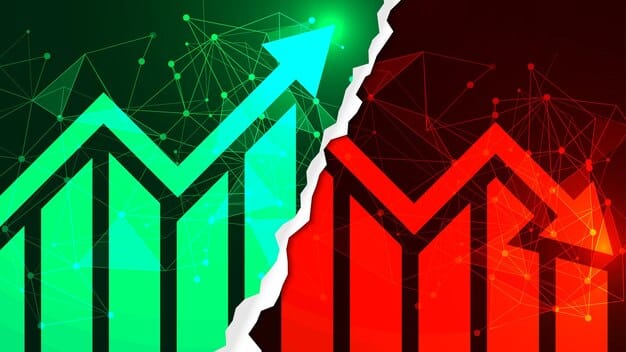Is the Economy Booming? Fact-Checking the President’s Metrics

Is the Economy Really Booming? A fact check examining the President’s claims about economic performance using metrics like GDP growth, job creation, inflation, and unemployment rates, providing an objective analysis of the current economic state.
Is the U.S. economy truly experiencing a boom under the current administration? Claims of unprecedented economic success frequently dominate headlines, but a deeper dive into key economic indicators is crucial to separate fact from political rhetoric. This article provides a detailed fact check of the President’s economic performance metrics, offering an objective assessment of the current economic landscape.
Decoding the “Boom”: An Overview
The assertion of a booming economy often hinges on carefully selected data points. GDP growth, unemployment rates, and stock market performance are frequently cited as evidence of economic vitality. However, a comprehensive analysis requires considering these metrics in conjunction with inflation, wage stagnation, and income inequality.
This section provides a broad overview of the key economic indicators often used to support claims of a booming economy, setting the stage for a more granular fact-checking exercise in subsequent sections.
Key Economic Indicators
Several indicators are commonly used to gauge the health of the economy:
- GDP Growth: A measure of the total value of goods and services produced in a country.
- Unemployment Rate: The percentage of the labor force that is unemployed but actively seeking employment.
- Inflation Rate: The rate at which the general level of prices for goods and services is rising, and subsequently, purchasing power is falling.
- Job Creation: The net increase in the number of jobs added to the economy.
The Narrative vs. The Reality
While some indicators might paint a positive picture, others can reveal underlying weaknesses. For example, a low unemployment rate might coexist with stagnant wages, indicating that many people are employed but not necessarily thriving financially.

Therefore, it’s crucial to analyze these indicators holistically to gain a balanced understanding of the economic situation.
In conclusion, claims of a booming economy require careful scrutiny. By examining a range of economic indicators and considering their interrelationships, we can move beyond simplistic narratives and gain a more nuanced understanding of the current economic landscape.
GDP Growth: Exaggerated or Justified?
Gross Domestic Product (GDP) growth is often the headline figure used to demonstrate economic success. It represents the total value of goods and services produced within a country’s borders during a specific period. However, the significance of GDP growth can be nuanced and requires careful interpretation.
This section examines the recent GDP growth figures, comparing them to historical trends and exploring the factors that contribute to economic expansion.
Understanding GDP Components
GDP is calculated by summing up various components:
- Consumer Spending: Purchases of goods and services by households.
- Investment: Spending by businesses on capital goods, such as equipment and buildings.
- Government Spending: Expenditures by federal, state, and local governments.
- Net Exports: The difference between a country’s exports and imports.
Recent GDP Performance
Recent GDP growth figures may appear impressive at first glance. However, it’s important to consider the context. For instance, growth following a period of economic contraction (like a recession) is often amplified due to the “base effect.”
Furthermore, some sectors may be driving growth while others lag behind. A strong performance in the tech sector, for example, might mask weaknesses in manufacturing or retail.
In conclusion, while GDP growth is an important indicator, it should not be viewed in isolation. A deeper analysis of its underlying components and a comparison to historical trends are essential for a comprehensive understanding of economic performance.
Job Creation: Quantity vs. Quality
The number of jobs created is another frequently cited metric to support claims of economic prosperity. A growing job market can signify increased economic activity and opportunity. However, the quality of those jobs – wages, benefits, and stability – is equally important.
This section delves into the job creation figures, analyzing the types of jobs being added and their implications for workers’ financial well-being.

Part-Time vs. Full-Time Employment
A significant increase in part-time jobs, while contributing to the overall job count, may not reflect a truly booming economy. Part-time positions often offer lower wages and fewer benefits compared to full-time jobs, potentially leading to financial instability for workers.
Furthermore, the prevalence of “gig economy” jobs, while providing flexibility for some, can also raise concerns about job security and access to benefits like health insurance and retirement plans.
Wage Growth and Stagnation
Even with job creation, wage growth may not keep pace with inflation. This can erode purchasing power, making it difficult for workers to afford basic necessities.
In conclusion, while job creation is a positive sign, it’s crucial to examine the types of jobs being added and whether wages are keeping pace with the rising cost of living. A focus solely on the quantity of jobs without considering their quality can paint an incomplete picture of the economic reality.
Inflation: The Silent Thief?
Inflation, the rate at which prices for goods and services rise, can significantly impact the economy and individual purchasing power. Moderate inflation is generally considered healthy, but excessive inflation can erode savings and make it difficult for families to make ends meet.
This section examines the current inflation rate, exploring its causes and potential consequences for consumers and businesses.
Causes of Inflation
Inflation can be caused by various factors:
- Demand-Pull Inflation: Occurs when there is too much money chasing too few goods, leading to increased prices.
- Cost-Push Inflation: Arises when the cost of production (e.g., raw materials, labor) increases, leading businesses to raise prices.
- Increased Money Supply: When the government prints more money, it devalues the existing currency, leading to inflation.
Impact on Consumers and Businesses
High inflation can disproportionately affect low-income households, who spend a larger portion of their income on essential goods like food and energy. It can also reduce consumer confidence and discourage spending, potentially slowing economic growth.
For businesses, high inflation can lead to uncertainty and difficulty in planning for the future. It can also erode profit margins if businesses are unable to pass on cost increases to consumers.
In conclusion, inflation is a critical economic indicator that requires careful monitoring. While moderate inflation is generally considered healthy, excessive inflation can have significant negative consequences for consumers and businesses.
Unemployment Rate: A Misleading Indicator?
The unemployment rate, often touted as a key measure of economic health, represents the percentage of the labor force that is unemployed but actively seeking employment. However, the unemployment rate can be a misleading indicator if not interpreted within a broader context.
This section explores the limitations of the unemployment rate and examines factors that can distort its true meaning.
Labor Force Participation Rate
The unemployment rate only considers individuals who are actively seeking employment. It does not include those who have given up looking for work (discouraged workers) or those who are underemployed (working part-time but seeking full-time employment).
Hidden Unemployment
The “real” unemployment rate, which includes discouraged workers and those marginally attached to the labor force, often provides a more accurate picture of the labor market’s health.
Furthermore, the unemployment rate does not capture the quality of jobs. A low unemployment rate might coexist with a large number of low-paying, unstable jobs, indicating that many people are employed but not necessarily thriving financially.
In conclusion, while the unemployment rate is a useful indicator, it should not be viewed in isolation. A broader analysis of labor force participation, underemployment, and job quality is essential for a comprehensive understanding of the labor market’s health.
National Debt and Deficit: The Elephant in the Room
While immediate economic indicators like GDP growth and unemployment often dominate the conversation, the national debt and deficit represent longer-term fiscal challenges that can have significant implications for future economic stability. Ignoring these factors while touting a “booming” economy can be shortsighted.
This section examines the current state of the national debt and deficit, exploring their potential impact on future generations.
Understanding the Debt and Deficit
- National Debt: The total amount of money owed by the federal government to its creditors.
- Budget Deficit: The difference between the federal government’s spending and its revenue in a given year.
Potential Consequences
A growing national debt can lead to higher interest rates, making it more expensive for the government to borrow money. This can crowd out private investment and slow economic growth.
Furthermore, a large national debt can increase the risk of a fiscal crisis, potentially undermining investor confidence and triggering economic instability.
In conclusion, while immediate economic indicators may appear positive, it’s crucial to consider the long-term fiscal implications of the national debt and deficit. Ignoring these factors can lead to a distorted view of the overall economic situation.
Inequality: Who Benefits from the “Boom”?
Even if the economy is indeed “booming” by certain metrics, it’s essential to ask: who is benefiting from this prosperity? Income inequality, the gap between the rich and the poor, can undermine social cohesion and limit economic opportunity for many.
This section examines the trend of income inequality and its implications for the overall well-being of society.
The Widening Gap
The gap between the rich and the poor has been widening for decades in the United States. This trend is driven by various factors, including globalization, technological change, and changes in tax policy.
Consequences of Inequality
High levels of income inequality can lead to social unrest and political instability. It can also limit economic mobility, making it difficult for individuals from low-income backgrounds to climb the economic ladder.
Furthermore, extreme inequality can concentrate economic and political power in the hands of a few, potentially undermining democratic institutions.
In conclusion, even if the economy is growing, it’s crucial to ensure that the benefits of that growth are shared broadly. Addressing income inequality is essential for creating a more just and sustainable economy.
| Key Aspect | Brief Description |
|---|---|
| 📊 GDP Growth | Examine growth components and historical context. |
| 💼 Job Creation | Assess job quality, wages, and full-time vs. part-time roles. |
| 💰 Inflation | Understand causes and impact on purchasing power. |
| ⚖️ Income Inequality | Analyze the wealth gap and its societal consequences. |
Frequently Asked Questions
▼
GDP or Gross Domestic Product, is the total value of goods and services produced within a country’s borders. Tracking GDP helps understand economic expansion or contraction, informing policy decisions.
▼
Inflation erodes your purchasing power. As prices rise, each dollar buys fewer goods and services than it did before, impacting your ability to afford necessities.
▼
The unemployment rate indicates the percentage of the labor force actively seeking work but unable to find it. However it doesn’t account for underemployment or discouraged workers.
▼
A high national debt can lead to increased interest rates and reduce the government’s capability to invest in key areas such as infrastructure or education hindering economic progress.
▼
Income inequality causes social instability and limits chances for upward mobility, creating disparities in access to opportunities, particularly for those from lower-income backgrounds.
Conclusion
In conclusion, assessing whether the economy is truly “booming” requires a nuanced approach that goes beyond surface-level metrics and considers a wide range of indicators, from GDP growth and job creation to inflation, national debt, and income inequality. A comprehensive fact check reveals that while certain aspects of the economy may be performing well, significant challenges remain, requiring careful attention and policy solutions.





